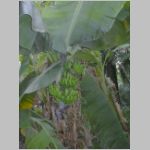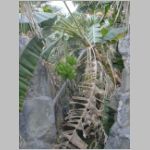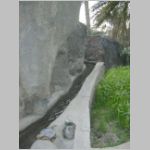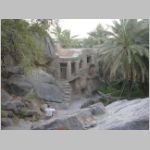Nizwa, Misfah April 2004
Nizwa, Misfah April 2004
 by Brien
Holmes by Brien
Holmes
A trip to Nizwa would be incomplete without a visit to the Friday market at
the Nizwa Fort!
The animal souq at the Friday market now draws hundreds of tourists each
weekend to witness the traditional manner of selling livestock. Potential buyers
either sit on the circular centerpiece or form a huge circle, where, in a
counter clockwise motion, stockmen, young and old, parade -- or carry -- their
offerings, shouting out the latest bid or asking price.
Nearby, almost all of the old souq, located as they were on the perimeter of
the city wall, has been replaced with modern, efficient buildings. In most of
the buildings, city residents bargain for fresh vegetables, fish, honey, live
birds (pigeons), chickens and all manner of produce. In one area, old cooking
pots are being cleaned and repaired while, a few meters away, tuna weighing up
to 40 or 50 kg are being cleaned.
In the midst of the delightful chaos, are souvenir shops, shops with an
assortment of "antiques", including the Omani kanjaar, and general
stores. Inhale and you will catch the aroma of freshly roasted coffee beans from
around the world.
And around the corner is the last area of the original souq, this section
sometimes referred to as the spice souq. It is located inside the elaborately
carved east gate doors and consists largely of traditional shops, the wares
spilling out into the narrow passageway. Only one of the three passageways sees
many customers these days. Here and there are the original hardware stores,
selling handmade items along with inexpensive tools from China.
One of the original wells is still in operation, not far from the busiest of
the old hardware stores, a few meters from the east gate. In this section, most
of the covered roof has been removed while elsewhere in the old souq, the roof
provides welcome shadows and considerable character.
Near the section of the modern souq reserved for "truck sales",
there is a break in the old city's original mud brick wall. Walk inside and see
the city as it once was, mud brick buildings, palm gardens and fallaj networks.
In the crowded parking lot, entrepreneurs are ready to repair your shoes,
sell you some plants, or supply a mid-morning snack of freshly barbecued lamb.
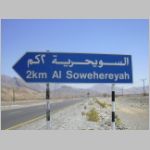
There are two signs to this village, each spelt differently; at first glance,
this one is suitable for lost tourists |
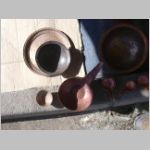
Metalworkers in the Nizwa souq cleaned old bowls, plates and milk pourers |
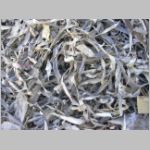
Dried sharks are skinned, this a pile of the skins removed |
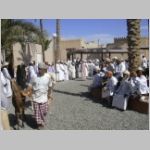
Selling cattle in the livestock market |
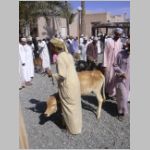
An owner stops to talk to a potential buyer |
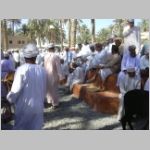
The market is dominated by men, but there are several women buying livestock |

Potential buyers on the 'wedding cake' styled centerpiece |

Tourists among the crowd, the visitors busy taking hundreds of photographs |
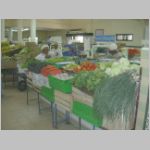
The produce market offers an incredible range of produce |

Fresh tuna lined up on the floor of the fish souq |
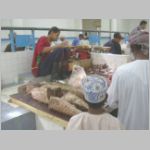
Fish mongers sit on platforms selling both fresh and barbecued tuna |
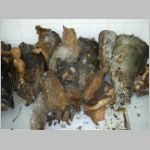
Some of the barbecued tuna in the market |
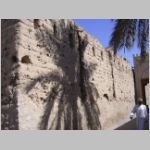
Shadow of a date palm on the wall of the old 'spice' souq |

The view into the old souq from the west gate |

The well, still in use |

All manner of debris stacked up the very edge of the well opening |
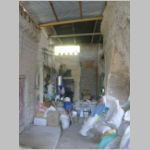
View into the hardware corner of the old souq |

One of the door panels of the east gate |

Even the trim around the doorway is elaborately carved |
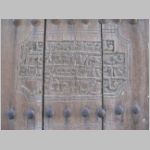
The Arabic inscription on one door panel |
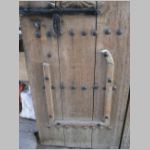
A postern gate may have been intended for this door panel |

Carved decoration and inscription on the gate |

Many shops in the old souq are closed, or used for storage |

"Foodstuff and Luxuries" were popular items to sell |
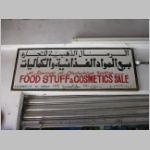
Despite the sign, few shops were selling any food |

Shelves offered an incredible assortment of items including toothbrush
(center), sandals, rope, hand tools and much more |
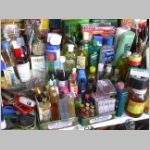
This part of the display featured "personal care items", next to
the hand tools (left) |

Farm implements beside bags of corn, dried lemons, rice and beans |

Some of the "antiques" are items not more than a few years old,
including plastic items |
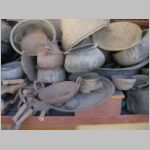
An assortment of tools, cooking pots and baskets |
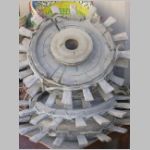
Pulley wheels from an old well, once powered by oxen or camels |

Detail of an old plough in front of Omani chests |
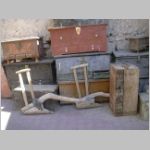
While the ploughs may be original, some of the chests are recent imports |
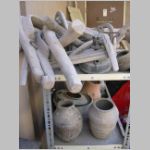
Many of the items are still in use in some oases in the UAE and Oman |
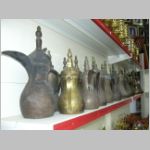
Old and new brass coffee parts, most showing signs of rushed repairs |
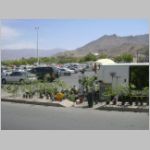
Decorative plants together with fruit trees sold in the parking area |

All that buying and selling works up an appetite |

Fresh mutton roasting over the coals |
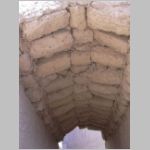
Not far from the bustle of the market, mud bricks used to form the ceiling of
this walkway |
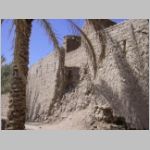
The original mud brick wall of the Nizwa fortified city |

Much of the wall and portions of surrounding buildings remain in good
condition |
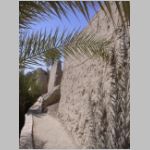
Just a few meters on the other side of this wall, the modern market is
crowded and busy |
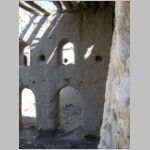
The interior of one of the remaining houses |
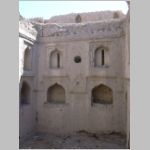
The decorative plastering of the house |
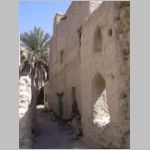
Houses here appeared to be predominantly two-storey structures |
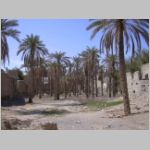
The abandoned palm garden, no longer receiving regular water via the fallaj |

Narrow alleyways and signs of electricity used in the old mudbrick buildings |
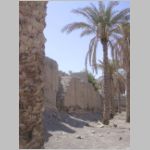
View along the wall to one of the remaining square towers |

Sections of the wall have collapsed |

The fallaj system does not appear to have been used in many years |
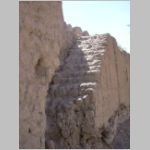
Steps leading to the rampart on top of the wall |

View along the wall to the corner round tower |
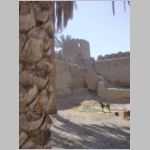
The corner tower with the staircase leading to the doorway |
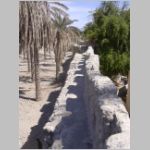
View along the top of the wall from the doorway of the round corner tower |
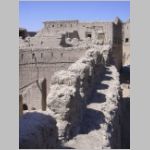
View along the other section of the wall, towards the residential area of the
old city |
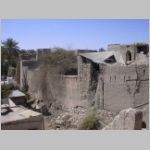
The wall, several meters in height, continues on towards the modern date
gardens |
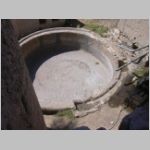
Just outside the wall, the reservoir associated with a well |
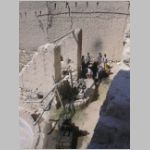
The well and superstructure, once sporting a pulley and rope drawn by oxen or
camels; today, boys tinkering with the old diesel engine |
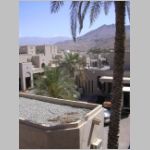
View from the round corner tower to the modern market buildings below |
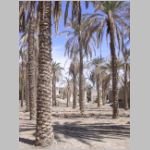
The neglected date palms |
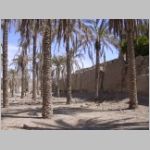
The size and condition of the palms suggest they were tended up until a few
years ago |
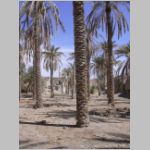
Through the date palms, the popular gold and blue minaret of the Nizwa mosque |
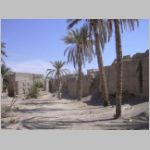
View diagonally across the garden, the abandoned fallaj in the foreground |

Considerable litter has collected in the neglected area |

A narrow passageway on the exterior of the wall |
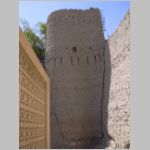
One of the original watch towers |
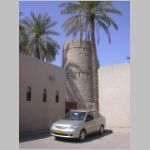
A modern cement wall covers the original mudbrick wall, in the vicinity of
the round corner tower |
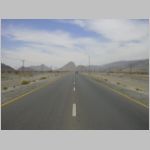
Heading back to Al Ain, Tanuf not far ahead on the right, the head of the
cliff walk barely visible (right) |

Colorful rock formations in the foreground, jagged mountains in the distance |
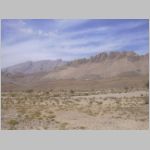
Mountains east of Nizwa suggest two forms of mountain building |

Some spectacular mountains along the roadway |
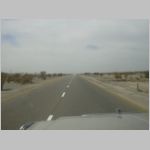
Approaching Ibri, the land becomes a flat gravel plain |

The "gap" providing access to the city of Ibri |

The Ibri fort watchtower on the horizon (left) |
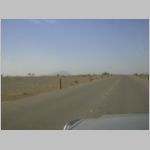
The unmistakable profile of Jebel Hafit |

From this perspective, the different slopes of the east and west faces is
very evident |

The two-lane highway will soon be four lanes wide |
Misfah
The ENHG weekend visitors stopped at a number of other sites around Nizwa,
including the remarkable mountain village of Misfah. The fading light of the
late afternoon made photography a challenge, so only a few photos are offered
below. Perhaps more will be added from those who had better light earlier in the
day.
|












































































